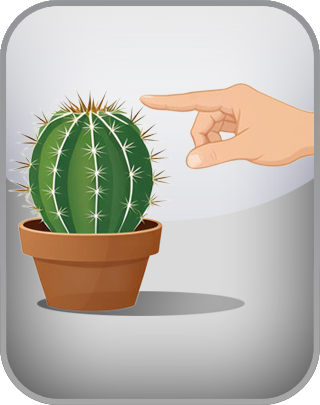Academically reviewed by Dr. Sabina Alispahić, Ph.D., professor of psychology
Touch Disgust Test
Christina Hartmann and Debra Lieberman at the University of Miami have discovered that people’s disgust at touch can be broken into various categories. The factors that determine why people differ on the various triggers for touch have largely been overlooked in research, but the work of these authors might contribute to a greater mapping out of individual differences in this regard.
Question 1 of 38
How unpleasant would you find it to touch:
An overripe, mushy banana.
| Disagree | Agree |
NEXT
The IDRlabs Touch Disgust Test was created by IDRlabs based on the scientific work of Dr. Robert E. Oum, Ph.D., at the University of Miami (and others).
The test measures the following triggers:
Slimy: Slimy textures can be associated with decaying matter or poisonous creatures. Our ancestors, who avoided touching slimy things, might have been less likely to get sick or encounter dangerous toxins.
Moist: Excessive moisture can harbor bacteria and fungus, which could lead to infections. Early humans living in environments with limited resources might have prioritized staying dry to conserve body heat and avoid illness.
Sticky: Getting stuck to something could have been a disadvantage for our ancestors. Sticky surfaces might have trapped them in dangerous situations or made it difficult to escape predators.
Rough: Rough surfaces could cause cuts, scrapes, and infections. Avoiding rough textures might have helped our ancestors stay healthy and avoid attracting parasites.
Hairy: Depending on the context, hairy textures could be associated with danger. Encountering hairy animals might have signaled a potential predator, while coarse human hair could be a sign of illness.
Powdery: Inhaling fine dust particles can irritate the lungs and potentially lead to respiratory problems. Early humans who avoided inhaling dust might have been less susceptible to infections and lung damage.
Sharp: Sharp objects pose a clear threat of injury. Our ancestors, who were more sensitive to sharp textures, might have been less likely to get cut, stabbed, or punctured, improving their chances of survival.
Wriggly: Many dangerous animals, like snakes and insects, have a wriggling movement. Aversion to wriggly things might have helped our ancestors avoid predators. Parasites like maggots or worms also often have a wriggling motion. Avoiding them could have minimized the risk of parasitic infection.
Tactile disgust, also known as haptic disgust, is a visceral reaction to certain physical sensations or textures that are perceived as unpleasant, repulsive, or contaminating. Unlike other forms of disgust triggered by odors or visual cues, tactile disgust is evoked by the sense of touch. This sensation can provoke feelings of discomfort, nausea, or revulsion in individuals who experience it.
Common triggers of tactile disgust include slimy or sticky textures, such as wet food residue, greasy substances, or bodily fluids. Certain textures may be perceived as inherently "unclean" or "uncouth," leading to an aversion towards physical contact or interaction with them.
The origins of tactile disgust can be traced back to evolutionary mechanisms aimed at protecting individuals from potential sources of contamination or disease. In prehistoric times, encountering substances that were perceived as unclean or potentially harmful could pose significant health risks. As a result, the human brain developed a sensitivity to certain tactile stimuli associated with potential threats to physical well-being.
Individuals vary in their sensitivity to tactile disgust, with some people experiencing it more intensely than others. Cultural factors also play a significant role in shaping perceptions of what constitutes a "disgusting" texture or sensation, as societal norms and upbringing can influence one's aversion to certain tactile stimuli.
Understanding tactile disgust can be valuable in various contexts, including product design, sensory marketing, and psychology, as it sheds light on how touch influences human behavior, emotions, and decision-making processes.
Free online quizzes such as the present test do not provide professional assessments or recommendations of any kind; the test is provided entirely “as-is.” For more information about any of our online tests and quizzes, please consult our Terms of Service.
References
- Noam Markovitch, Liat Netzer & Maya Tamir (2016) Will you touch a dirty diaper? Attitudes towards disgust and behaviour, Cognition and Emotion, 30:3, 592-602.
- Robert E. Oum, Debra Lieberman & Alison Aylward (2011) A feel for disgust: Tactile cues to pathogen presence, Cognition and Emotion, 25:4, 717-725.
- Saluja, S., & Stevenson, R. J. (2019). Perceptual and cognitive determinants of tactile disgust. Quarterly Journal of Experimental Psychology, 72(11), 2705-2716.

 English
English  Español
Español  Português
Português  Deutsch
Deutsch  Français
Français  Italiano
Italiano  Polski
Polski 